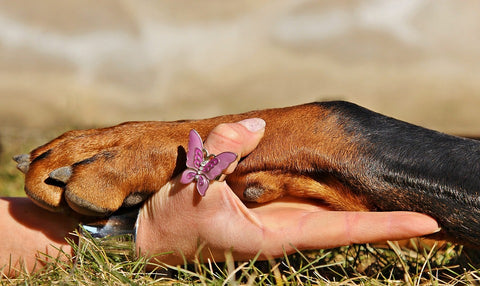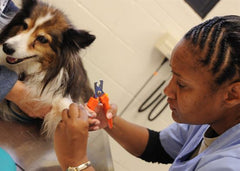
Keeping your dog’s nails trimmed is an important part of caring for your canine friend. While many people elect to have their veterinarian or pet groomer trim their dog’s claws, it can be much less expensive to invest in a pair of dog nail clippers and do the trimming at home! And because many dogs feel anxiety at the groomer or vet, trimming their nails at home can be much less stressful for your pup as well.
Prior to your first time trimming your dog’s nails, practice touching their feet and claws to get them used to being handled.
While some dogs are fine with having their nails trimmed, a lot of dogs can feel stress or fearful when having their feet touched. Once your dog is okay with having their paws handled, try to hold the clippers to the claw as if you would if you were trimming their nails, but don’t actually clip. This will get your dog used to the idea of having the strange tool near their paws. Throughout this practice reward your dog with praise and their favorite treats. Take up to a week or longer, as needed, to establish this positive association with feet touching.

Once your dog is comfortable with the idea of having his or her nails trimmed, it is time to pick out the right tool for the job.
There are two main styles of nail clippers, guillotine and scissor.
-
- Guillotine clippers are generally thought to have better control for more precise cuts, and they offer a better view of the nail while trimming.
-
- Scissor clippers feel more natural in the hand and can apply a lot more force for thicker nails. They also tend to stay sharper for longer.
Because both styles of clipper will generally accomplish the same thing, the most important things are that the clippers fit comfortably in your hand, that you are comfortable using them, and that they are appropriately sized for your pet’s nails.
Click here to download a coupon for all the supplies we recommend as well as a PDF of this guide!
The most important part of successful nail trimming is being well aware of what is called the dog’s “quick”.
The quick can usually be identified as the red “vein” within a dog’s nail that houses the nail’s nerves and blood vessels. The quick can range from very visible on a clear or light-colored nail, to impossible to see on a dark nail. Cutting your dog’s nails too short will result in severing the quick, which can lead to a lot of blood and pain for your pup.
When a nail is cut too short, and the quick is exposed, a dab of styptic powder on the nail will help stop bleeding and minimize pain.
Even seasoned nail trimmers can accidentally cut a dog’s nail too short and hit the quick from time to time, so it is important to have ready access to styptic powder.
Carefully and calmly hold your dog’s paw and extend out the first nail to be trimmed.

You will be able to tell you’re getting close to the quick when a pink or grey oval starts to appear on the exposed end of the nail. This is the beginning of the quick, and you should not cut any further. Using sharp clippers and cutting in swift, precise motions will lead to cleaner trimming and less likelihood that your dog will accidentally be injured in the process.
If it has been too long since your dog’s last nail trim, it is common for the nail’s quick to grow out with the nail, becoming too long and making it difficult to adequately trim. If the quick has grown out too far, just cut as close as you can and allow the quick one week to recede. The quick will naturally withdraw back into the nail, giving you more space to trim. Trim the nails again, as close to the quick as you can, and continue this process until the quick has receded back to an appropriate length.
If you are unable to trim the nails and they have grown to a dangerous length, a veterinarian might be needed. Remember, long nails have a better chance of getting torn, ripped out, or cracked, which can lead to a hefty vet bill and a lot of unnecessary pain for your dog.
Establish positive associations with the nail trimming process by continually rewarding your dog’s good behavior with treats.
This will make future nail trimmings easier and more enjoyable for you and your dog. With regular practice, you can become a champion nail trimmer and help keep your pup happy and healthy over the long term!


